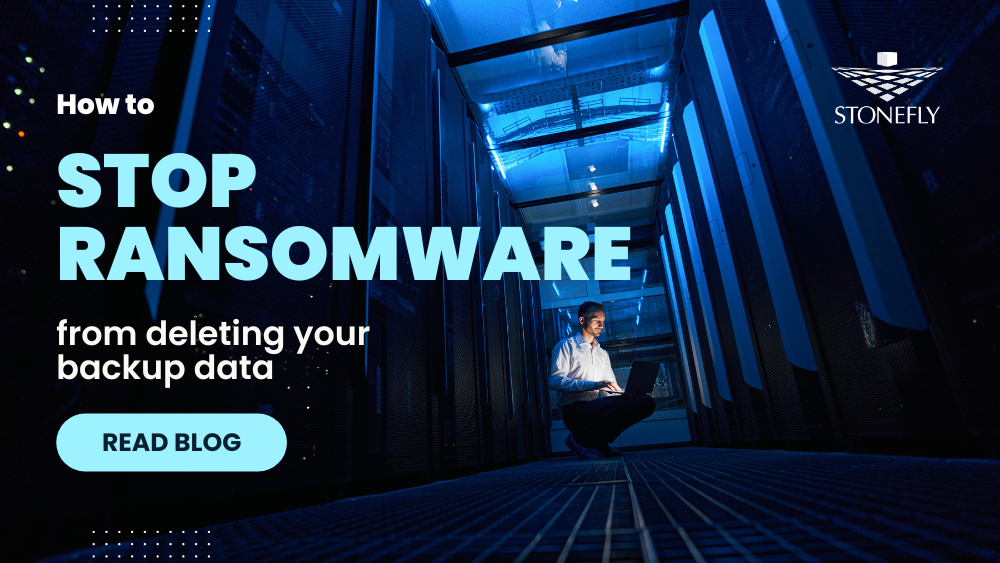Ransomware attacks have become increasingly sophisticated, posing a significant threat to organizations across various industries. In recent times, these attacks have taken a concerning turn, targeting backup data and aiming to cripple organizations by eliminating their last line of defense. This blog delves into the urgent need for protecting backup data from ransomware attacks and explores how StoneFly’s backup and disaster recovery solutions offer robust defenses against this emerging threat.
Why is it necessary to protect backup data from deletion
Backup data serves as a vital defense against the devastating consequences of ransomware attacks. By creating copies of critical systems and data, organizations can regain control and restore operations in the event of an attack.
Cybercriminals have become increasingly aware of the value of backup data and have developed sophisticated techniques to target and compromise these essential lifelines. One such alarming trend is the deliberate deletion or corruption of backup data by threat actors, depriving organizations of their last line of defense.
The act of deleting or rendering backup data useless not only hinders the recovery process but also puts organizations in a precarious position where paying the ransom may seem like the only viable option. This targeted assault on backup data undermines the very purpose of having robust data protection measures in place. It highlights the urgent need for organizations to take proactive steps to safeguard their backup infrastructure and prevent ransomware attacks from annihilating critical data backups.
In this ever-evolving landscape of cyber threats, protecting backup data has become paramount for maintaining operational continuity and preventing significant financial and reputational losses.
By implementing effective strategies and leveraging advanced technologies, organizations can fortify their backup systems against ransomware attacks, ensuring the integrity and availability of their critical data.
Ransomware’s Evolving Tactics: Targeting Backup Data
Ransomware attacks have taken an alarming turn as threat actors increasingly target backup data for deletion. This section explores the methods and implications of these evolving tactics.
Common Methods Used to Delete Backup Data
Threat actors employ various methods to delete backup data and undermine recovery efforts. Some common techniques include:
- Encryption-based Attacks: Ransomware encrypts backup files or the entire backup infrastructure, rendering them inaccessible without the decryption key.
- Credential Theft: Attackers exploit compromised credentials to gain unauthorized access to backup systems, allowing them to delete or manipulate backup data.
- Deletion of Backup Software Configuration: Ransomware may delete critical configuration files, such as registry entries or batch scripts, that are essential for the proper functioning of backup software. This disrupts backup operations and compromises data recovery.
- Network-based Attacks: Ransomware spreads across the network, infiltrating backup servers and storage devices. Once inside, it can delete or overwrite backup data, rendering it useless for recovery purposes.
Implications of Backup Data Deletion
The consequences of ransomware deleting backup data are severe and wide-ranging. Organizations face the following implications:
- Loss of Data Recovery Capability: Without intact backup data, organizations lose their ability to restore systems and data to a pre-attack state, significantly hampering their recovery efforts.
- Increased Downtime: In the absence of reliable backups, organizations experience prolonged operational downtime, resulting in financial losses and diminished productivity.
- Potential Permanent Data Loss: Deleted backup data increases the risk of permanent data loss, as recovery options become limited or nonexistent.

Vulnerabilities in Traditional Backup Solutions
Traditional backup solutions often lack the necessary security measures to prevent the deletion of backup data by ransomware. Connected systems, weak access controls, and insufficient data protection mechanisms make them susceptible to compromise.
Connected Systems: In traditional backup solutions, the backup infrastructure is often interconnected with production systems, providing a pathway for ransomware to propagate and target backup data. Once ransomware gains access to the production environment, it can move laterally to compromise backup systems and delete backup data.
Weak Access Controls: Insufficient access controls within traditional backup solutions can leave them vulnerable to unauthorized access. Weak or default passwords, lack of multi-factor authentication, and inadequate user privilege management make it easier for threat actors to gain unauthorized access to backup systems and manipulate or delete data.
Insufficient Data Protection Mechanisms: Traditional backup solutions may lack robust data protection mechanisms such as encryption and immutability. Without these safeguards, backup data remains vulnerable to tampering and deletion by ransomware. Additionally, inadequate monitoring and auditing capabilities can make it challenging to detect and respond to unauthorized activities targeting backup data.
How to Protect Backup Data from Deletion
StoneFly offers advanced backup and disaster recovery solutions designed to provide robust ransomware protection. By implementing these solutions, organizations can secure their backup data and ensure operational continuity in the face of evolving cyber threats.
Data Security Features for Preventing Ransomware Deletion
Air-gapped and Immutable Repositories
StoneFly’s backup solutions provide air-gapped and immutable repositories for data storage. This dual protection mechanism ensures that backup data remains isolated/detached/unplugged from the production environment and cannot be modified or deleted by ransomware.
Air-gapping ensures physical/logical separation, while immutability ensures that backup files are read-only and write-protected, for a set retention period, preventing unauthorized tampering or deletion.
Multi-factor Authentication (MFA) for Administrative Tasks
StoneFly’s solutions incorporate multi-factor authentication (MFA) to secure critical actions like deleting snapshots, volumes, and the resource used to host the volumes. Administrators with privileged access must go through the multi-factor authentication (MFA) process each time they attempt to delete a snapshot, backup, volume, or resource.
MFA adds an extra layer of security, requiring multiple forms of verification, such as passwords and unique codes, to prevent unauthorized deletion attempts by ransomware actors with administrative privileges.
Volume Deletion Protection
Volume deletion protection is a robust feature provided by StoneFly’s backup and disaster recovery solutions. When enabled, it prevents the deletion of volumes completely. To disable volume deletion protection, a stringent protocol is followed. This involves contacting StoneFly support, verifying the request with two authorized personnel, and generating a unique code to disable the protection. This ensures that ransomware, malware, hackers, and rogue administrators cannot delete volumes, enhancing the resilience of backup data against ransomware attacks.
Immutable Snapshots with Flexible Retention
StoneFly’s solutions include the capability to schedule immutable snapshots at regular intervals. These snapshots capture the state of the data at a specific point in time and ensure its integrity and immutability. The flexible retention options allow organizations to retain these immutable snapshots for extended periods, providing a secure and reliable restore point in the event of a ransomware attack.
Conclusion
Safeguarding backup data from ransomware attacks is crucial for organizations to maintain operational continuity and protect against data loss. With the increasing sophistication of ransomware tactics targeting backups, robust defense measures are necessary. Implementing air-gapped and immutable repositories, multi-factor authentication for critical tasks, volume deletion protection, and immutable snapshots can significantly enhance your defenses. Prioritize ransomware protection and fortify your backup strategy to ensure the resilience of your organization’s data in the face of evolving cyber threats.
Don’t wait for an incident to strike – take action today and fortify your organization’s data security. Talk to our experts to discuss your backup environment(s).










